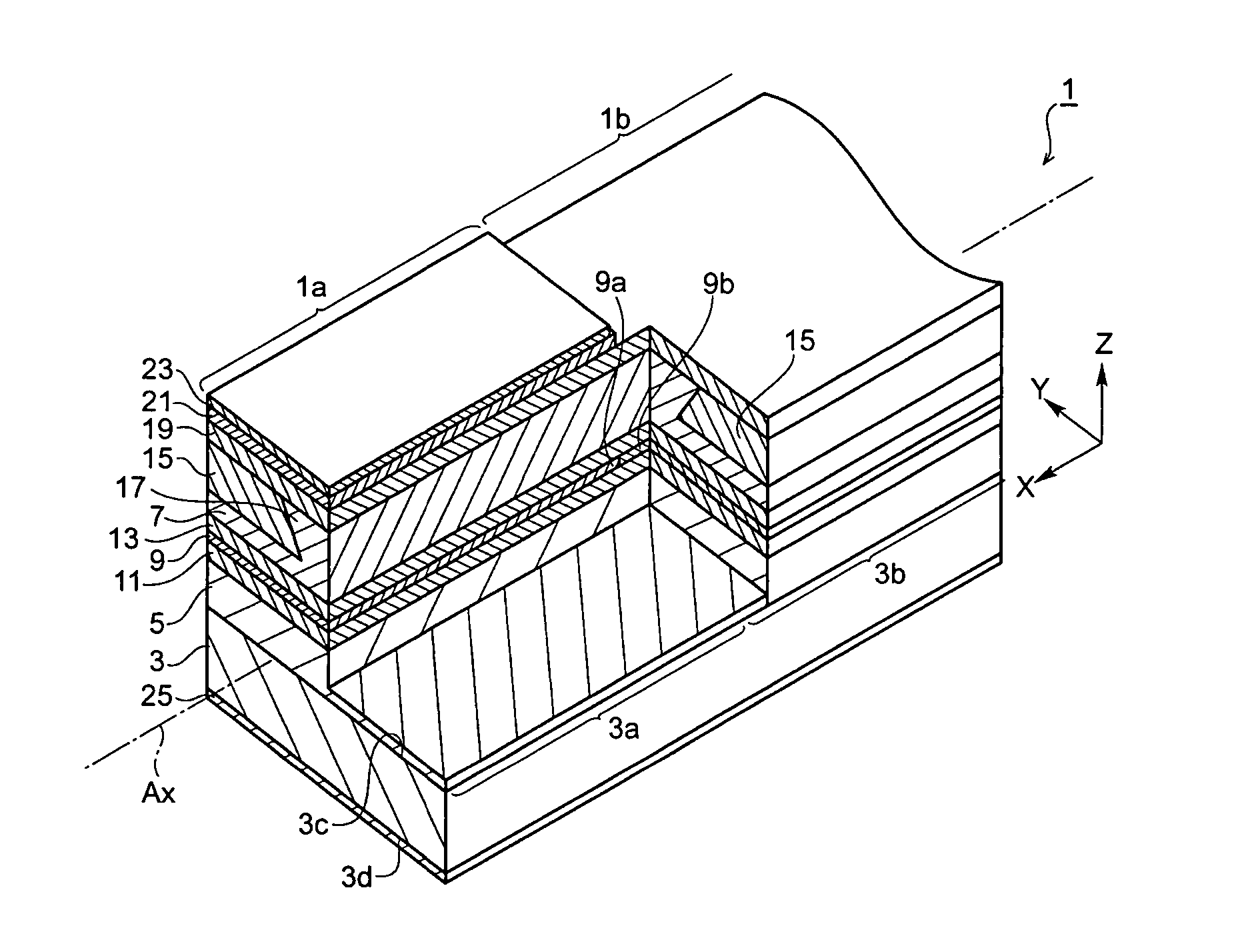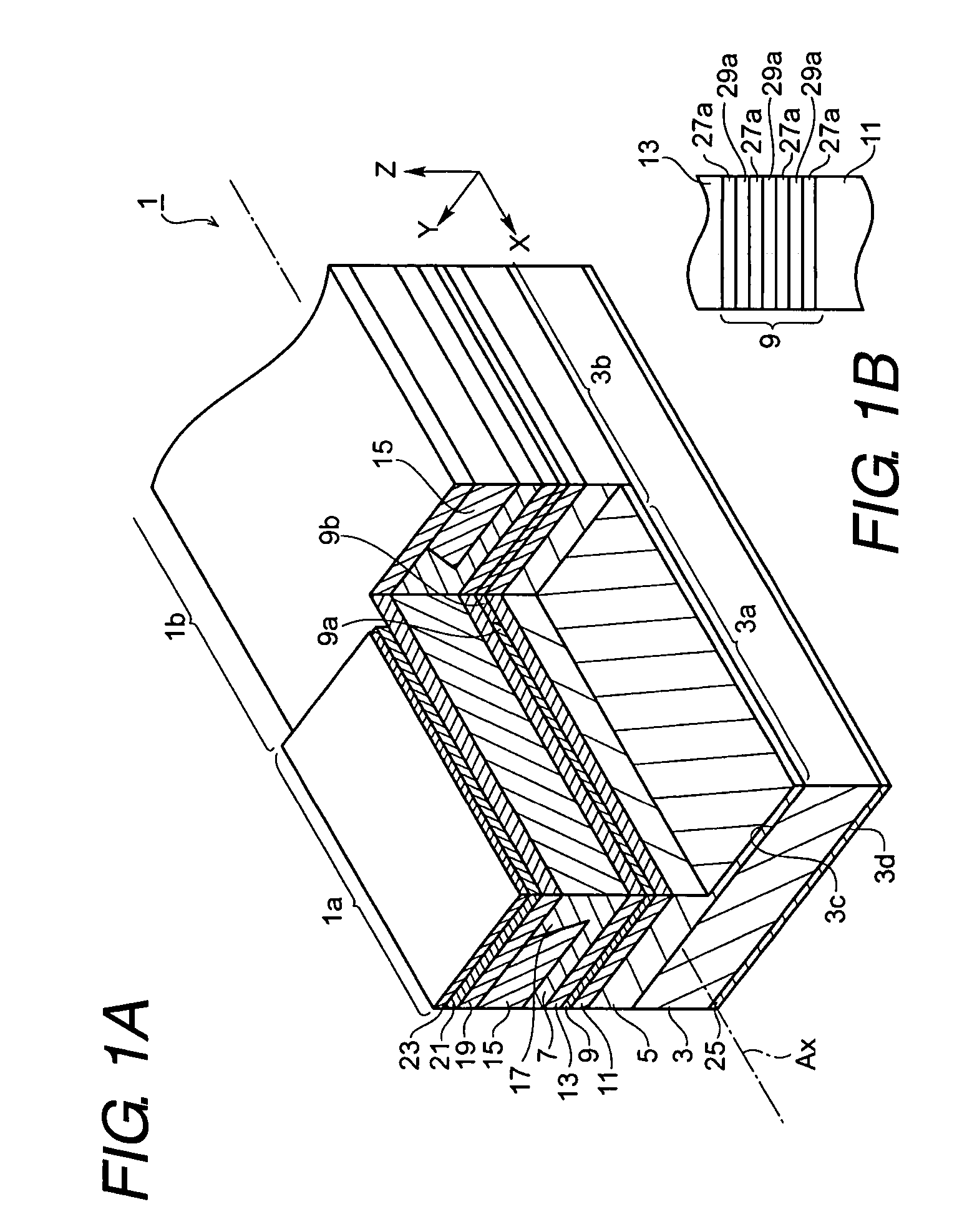Optical integrated device
a technology of integrated devices and optical components, applied in the field of optical devices, can solve the problems of reducing reducing the performance of the device against the temperature, and inevitably induced reflection of light at the interface, so as to narrow widen the band gap energy of the effect of the effect of widening the effective width of the well layer
- Summary
- Abstract
- Description
- Claims
- Application Information
AI Technical Summary
Benefits of technology
Problems solved by technology
Method used
Image
Examples
first embodiment
[0035
[0036]FIG. 1A is a perspective view showing an optical integrated device 1 according to the present invention, and FIG. 1B is a schematic diagram showing a structure of an active layer of the optical integrated device 1.
[0037]The optical integrated device 1 comprises a GaAs substrate 3, a first cladding layer 5, a second cladding layer 7, and an active layer 9. The GaAs substrate, with a first conduction type and a primary surface 3c of a (100) crystallographic surface, provides a first region 3a where a first device 1a is formed thereon and a second region 3b where a second device 1b is disposed thereon. These first and second regions are arranged along an axis Ax. The first cladding layer 5, showing the first conduction type, is formed in both the first and second regions, 3a and 3b, respectively. The second cladding layer 7, showing a second conduction type, is also formed in the first and second regions, 3a and 3b. The second cladding layer 7, as shown in FIG. 1A, provides ...
second embodiment
[0045
[0046]Next, a process for manufacturing the optical integrated device shown in FIG. 1A will be described as referring to drawings from FIG. 2A to FIG. 2D.
[0047]First, as shown in FIG. 2A, a plurality of semiconductor layers, namely, the first cladding layer 43, the first optical confinement layer 45, the active layer 47, the second optical confinement layer 49, the second cladding layer 51, and the cap layer 53 are grown on a GaAs wafer 41 by the Organo-Metallic Vapor Phase Epitaxy (OMVPE) technique. The first cladding layer 43 has the first conduction type, while the second cladding layer 51 has the second conduction type. The active layer 47, as described previously, has the multi-quantum well structure with a plurality of well layers and barrier layers alternately stacked to each other. The cap layer 53, which covers semiconductor layers formed thereunder, is GaAs. The semiconductor layers for the first device la is provided on the first region 41a, while the layers for the ...
third embodiment
[0074
[0075]FIG. 8A is a perspective view showing another optical integrated device 101 according to the third embodiment of the invention, and FIG. 8B is a schematic diagram showing a layer structure of an active layer of the device shown in FIG. 8A .
[0076]The optical integrated device 101 provides a similar structure to those shown in the previously explained device 1 except that the active layer 109, the first and second cladding layers, 105 and 107, and the upper and lower optical confinement layers, 111 and 113, form a mesa 117, while only the upper cladding layer makes the ridge in the first embodiment.
[0077]Similar to the previous embodiment, the mesa 117 extends from the first region 3a to the second region 3b. The active layer 109a in the first device 101a also smoothly continues to the second active layer 109b. Both the first and second active layers, 109a and 109b, are sandwiched by the first and second optical confinement layers, 111 and 113, in respective regions, 101a a...
PUM
 Login to View More
Login to View More Abstract
Description
Claims
Application Information
 Login to View More
Login to View More - R&D
- Intellectual Property
- Life Sciences
- Materials
- Tech Scout
- Unparalleled Data Quality
- Higher Quality Content
- 60% Fewer Hallucinations
Browse by: Latest US Patents, China's latest patents, Technical Efficacy Thesaurus, Application Domain, Technology Topic, Popular Technical Reports.
© 2025 PatSnap. All rights reserved.Legal|Privacy policy|Modern Slavery Act Transparency Statement|Sitemap|About US| Contact US: help@patsnap.com



